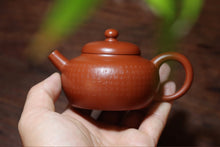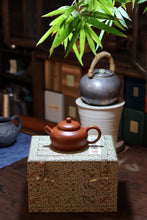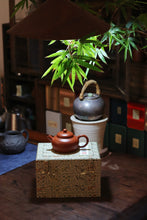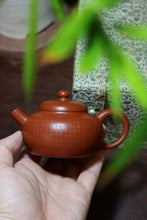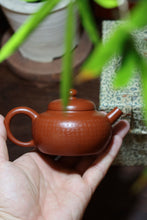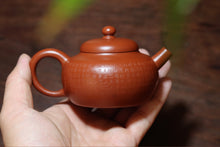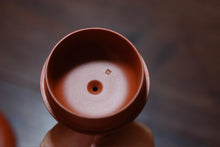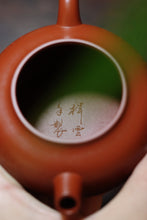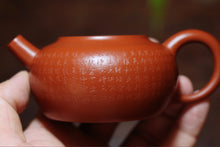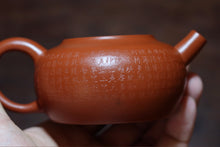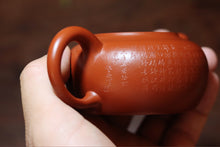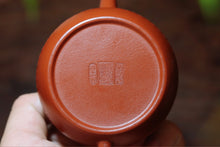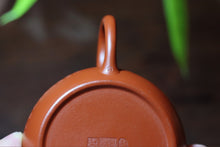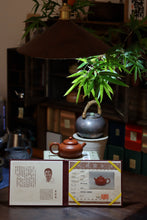
In the Tongxin She Teahouse, where the fragrance of tea lingers, every corner exudes a leisurely atmosphere. Among all the treasures here, the most radiant one is undoubtedly Master Hui Xiangyun's original ore old Zhuni clay "Heart Sutra Pot" collected by the teahouse. This teapot is like a refined scholar who has traveled through time, quietly narrating the harmonious blend of purple sand art and Buddhist culture.
This "Heart Sutra Pot" has a capacity of 150cc. It is small and exquisite yet full of charm. When held in the hand, it feels as if one is grasping the profoundness of history. It was fired at a temperature of 1150 degrees Celsius. Under the淬炼 of high temperature, the original ore old Zhuni clay shows a unique texture. Its color is warm and simple, just like the depth after the precipitation of time. What's more astonishing is the "Heart Sutra" hand-engraved on the body of the pot. As an extremely important scripture in Mahayana Buddhism, the "Heart Sutra" is profound in meaning despite its concise words. It is recited daily by countless Buddhist monks and lay practitioners. Engraving these words full of wisdom on the teapot body complements the introverted and profound characteristics of the silver teapot. The silver teapot carries the charm of traditional culture. When combined with the wisdom of the "Heart Sutra", it elevates to a realm that transcends the mundane world. It is not only a practical tea set but also an art treasure carrying culture and belief, highlighting its unique social value.
When talking about this teapot, we have to mention its creator, Master Hui Xiangyun. Master Hui was born into a family with a long history of pottery-making in Yixing. As the 15th-generation descendant of Master Hui Mengchen, a renowned purple sand pot maker in the Ming Dynasty, he has the blood of purple sand art flowing in his veins. The story of Master Hui Mengchen, a figure who left a significant mark in the history of purple sand, adds a touch of legend to the "Heart Sutra Pot". During the late Ming and early Qing dynasties, overseas trade was booming. The wealthy merchants in the Chaoshan area loved Gongfu tea. They invited Hui Mengchen to Chaozhou through their connections and asked him to make teapots according to their requirements. Since then, Hui Mengchen's Zhuni clay teapots became widely known and became his representative works, even though he didn't make Zhuni clay teapots in the early days and was also good at making large teapots. Even on many silver tea sets of the British royal family, the shadow of Hui Mengchen's classic pear-shaped teapot can be seen, which shows how far-reaching his influence was.
Master Hui Xiangyun learned the art of making teapots from his father since childhood and later studied under Master He Daohong, a Chinese master of ceramic art. He has a solid foundation and excellent craftsmanship. He has a deep understanding of purple sand and is known as the "Folk Master of Purple Sand" by collectors. Jin Yong inscribed the words "Hui Xiangyun's Purple Sand Treasures" for him, and Master Qi Gong personally wrote "Xiangyun's Teapot Art Dares to Reach for the Peak", which is undoubtedly a high recognition of his artistic achievements. Since the 1990s, concerned about the excessive mining of purple sand ore sources, Master Hui Xiangyun began to collect high-quality ore sources vigorously and was jokingly called the "Old Man Who Hoards Clay" by the industry. Every piece of his work is meticulous in material selection, shape design, and production process. It is exquisite and has no trace of shoddy workmanship. The "Heart Sutra Pot" is a prime example, with extremely high artistic appreciation and collection value.
In the Tongxin She Teahouse, this original ore old Zhuni clay "Heart Sutra Pot" by Master Hui Xiangyun is not just a tea set. It is a treasure that integrates history, culture, art, and belief. When people gently hold it and make a cup of fragrant tea, amidst the fragrance of tea and the charm of the teapot, they seem to be able to feel the passage of time, the inheritance of culture, and the ingenuity of the artist.
















